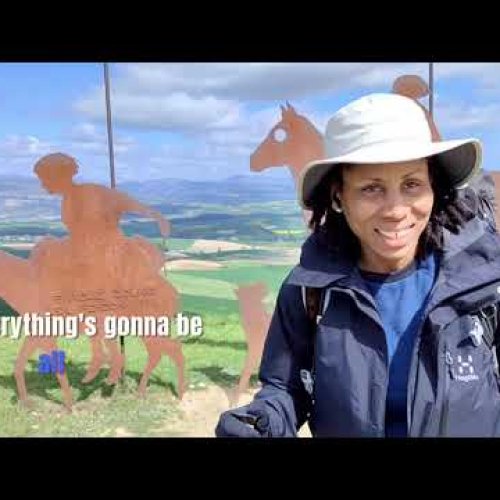sillydoll
Veteran Member
- Nov 2, 2004
- 6,742
- 2,283
- Time of past OR future Camino
- 2002 CF: 2004 from Paris: 2006 VF: 2007 CF: 2009 Aragones, Ingles, Finisterre: 2011 X 2 on CF: 2013 'Caracoles': 2014 CF and Ingles 'Caracoles":2015 Logrono-Burgos (Hospitalero San Anton): 2016 La Douay to Aosta/San Gimignano to Rome:
The itinerary of the route of el Camino de Santiago Catalan is fully marked with the distinctive blue and yellow arrows and can be explored on foot, by bicycle or on horseback. This is a very successful road for Catalans - 10% of the pilgrims who arrive each year in Santiago come from Catalonia - and besides, Catalonia has a score of Associations of Friends of the Camino de Santiago who are responsible for the upkeep the sections of the Jacobean route, edit the guides and serve the pilgrims who begin their journey in Catalonia.
This path is also a link between the east and west of the Iberian Peninsula, between Catalonia and Galicia, among the monasteries of Sant Pere de Rodes and Compostela.
The route of el Camino de Santiago Catalan begins in the Mediterranean town of Port de la Selva (Costa Brava), with the emblematic Monastery of Sant Pere de Rodes, an important medieval pilgrimage center. Another point of departure for pilgrims coming from Europe, is the Jonquera, on the border with France.
From Sant Pere de Rodes, the main section of the Camino de Santiago in Catalonia covers the towns of Figueres, Girona, Olot, Vic, Manresa, Montserrat, Igualada, Cervera, Tarrega, and Lleida until reaching Alcarrás, on the border with Aragon .
Another branch departs from Barcelona, Tarragona, and Tortosa Ebro Delta, and joins the main road to converge with the French route that goes to Santiago de Compostela.
The main section of the Camino de Santiago in Catalonia covers some 400 km. This distance can be covered on foot in about 15 days at about 25 km a day. The route is full of monuments and cultural attractions, many linked to the Jacobean iconography and large medieval pilgrimages, like the University of Cervera, the "Seu Vella" symbolic Lleida or monastery of Montserrat.
The Government has published a map guide which includes the entire path, a graph with the profile, the main cultural sites, natural areas near the route, sights and culinary sections adapted for accessible tourism. This map has been published in three bilingual versions: Catalan / Castilian, English, French, German / Italian.
Moreover, the Catalan government has also published two guidelines concerning the Camino de Santiago in Catalonia: the first comprises the section of Montserrat Alcarrás and the second part of Port de la Selva or the Jonquera, up to Montserrat. These guides contain historical and cultural references of the road and signs to prepare for the pilgrimage, maps of each stage and information on accommodations.
An interactive map
All information relating to the portions adapted from the Catalan path can be found in accessible media, on the web "Camino de Santiago in Catalonia for all http://www.camidesantjaumeperatothom.cat created by the Catalan Agency of Tourism.
In addition, this website allows you to download - by phone, computer or PDA - an audio guide, with signs for the blind and captions for the deaf, and contains information about cultural resources, natural history, or traditions, existing within a radius of 20 km from the Catalan path.
This path is also a link between the east and west of the Iberian Peninsula, between Catalonia and Galicia, among the monasteries of Sant Pere de Rodes and Compostela.
The route of el Camino de Santiago Catalan begins in the Mediterranean town of Port de la Selva (Costa Brava), with the emblematic Monastery of Sant Pere de Rodes, an important medieval pilgrimage center. Another point of departure for pilgrims coming from Europe, is the Jonquera, on the border with France.
From Sant Pere de Rodes, the main section of the Camino de Santiago in Catalonia covers the towns of Figueres, Girona, Olot, Vic, Manresa, Montserrat, Igualada, Cervera, Tarrega, and Lleida until reaching Alcarrás, on the border with Aragon .
Another branch departs from Barcelona, Tarragona, and Tortosa Ebro Delta, and joins the main road to converge with the French route that goes to Santiago de Compostela.
The main section of the Camino de Santiago in Catalonia covers some 400 km. This distance can be covered on foot in about 15 days at about 25 km a day. The route is full of monuments and cultural attractions, many linked to the Jacobean iconography and large medieval pilgrimages, like the University of Cervera, the "Seu Vella" symbolic Lleida or monastery of Montserrat.
The Government has published a map guide which includes the entire path, a graph with the profile, the main cultural sites, natural areas near the route, sights and culinary sections adapted for accessible tourism. This map has been published in three bilingual versions: Catalan / Castilian, English, French, German / Italian.
Moreover, the Catalan government has also published two guidelines concerning the Camino de Santiago in Catalonia: the first comprises the section of Montserrat Alcarrás and the second part of Port de la Selva or the Jonquera, up to Montserrat. These guides contain historical and cultural references of the road and signs to prepare for the pilgrimage, maps of each stage and information on accommodations.
An interactive map
All information relating to the portions adapted from the Catalan path can be found in accessible media, on the web "Camino de Santiago in Catalonia for all http://www.camidesantjaumeperatothom.cat created by the Catalan Agency of Tourism.
In addition, this website allows you to download - by phone, computer or PDA - an audio guide, with signs for the blind and captions for the deaf, and contains information about cultural resources, natural history, or traditions, existing within a radius of 20 km from the Catalan path.










